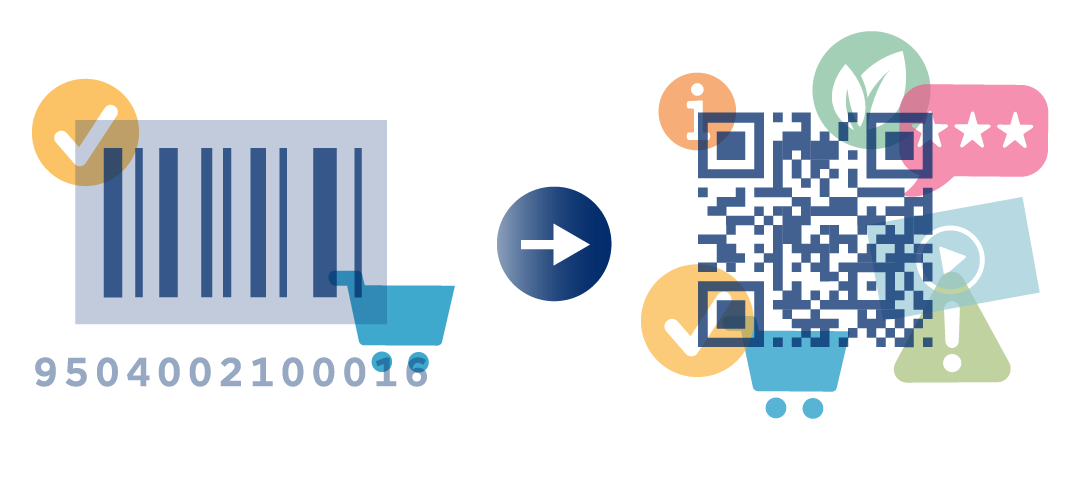How QR Codes with GS1 standards will replace traditional barcodes
Aug 6, 2024,
by Paul Connolly - Category: News, Webinar
2027: The Year of QR Codes in Global Retail
The retail landscape is on the brink of a transformative shift as we edge closer to 2027, a year earmarked for a significant transition in the way products are labelled and interacted with globally. The move from traditional barcodes to QR codes powered by GS1 standards represents not just a technological upgrade but a leap towards enhancing consumer experiences and ensuring unparalleled product traceability. Let's delve into the nuances of this transition and what it means for the global retail ecosystem.

The Evolution from Traditional Barcodes to QR Codes powered by GS1
For over 50 years, traditional barcodes have been the backbone of product identification, serving a critical role in the retail supply chain. However, as we navigate through an era marked by digital transformation, these traditional symbols have reached their capacity limits. Enter QR codes with GS1 Digital Link - a modern solution designed to meet the ever-growing consumer demands for information and businesses' need for advanced operational capabilities. These 2D barcodes can store vastly more data than their predecessors, opening up new avenues for consumer engagement and supply chain efficiency.

Enhancing Consumer Experience with Rich Product Information
In today's digital age, consumers crave information. From the ingredients and nutritional content of their food to the sustainability practices behind their favourite brands, the demand for transparency is at an all-time high. QR codes powered by GS1 standards are set to revolutionize how consumers interact with products. With a simple scan using a smartphone, individuals can access a wealth of information, from usage instructions and safety guidelines to recycling advice and brand stories, thereby fostering a higher level of engagement and trust between consumers and brands.
Meeting the Rising Demand for Product Transparency
The push for product transparency is not solely consumer-driven. Regulatory bodies worldwide are increasingly mandating detailed product disclosures to protect consumer interests and promote sustainable practices. The shift to QR codes with GS1 standards is a timely response to these demands, offering a streamlined way to communicate complex product information in a user-friendly manner. This transition is not just about keeping pace with regulations but setting a new standard in consumer empowerment and informed decision-making.

The Role of Leading Global Brands in the QR Code Transition
The move towards QR codes powered by GS1 is a collective effort, championed by some of the world's most influential brands. Leaders from the world’s biggest companies – including Alibaba, Carrefour, IGA, JD.com, JM Smucker, Mondelēz, Lidl, L’Oréal, Nestlé, P&G and others - have pledged their support for this transition, underscoring its importance across the retail sector. This united front is a testament to the industry's commitment to innovation and consumer-centricity. By adopting QR codes, these leaders are paving the way for a future where digital engagement and transparency are at the heart of every shopping experience.
Preparing Your Business for QR Code Implementation
For businesses, the transition to QR codes powered by GS1 is not just an operational change but a strategic opportunity to enhance brand perception and consumer loyalty. Publishing barcode data to the GS1 Global Registry via Barcode Manager is the first key step to allow brands to begin to take advantage of QR codes powered by our GS1 Digital Link standard. Furthermore, engaging with webinars and industry updates will ensure that businesses are well-informed and prepared for the upcoming changes. The journey towards 2027 is a chance for brands to reimagine their consumer interactions and supply chain management practices.
Looking Ahead: The Future of Shopping with QR Codes
As we look towards 2027, it's clear that QR codes are set to redefine the retail experience. Beyond the immediate benefits of enhanced product information and traceability, the adoption of QR codes powered by GS1 opens up exciting possibilities for innovation in customer engagement and loyalty programmes. Imagine a shopping experience that's not just transactional but interactive and informative, where every product has a story to tell and information to share. This is the future that QR codes promise, a future where retail is not just about what we buy but how we connect with the brands and products in our lives.
In conclusion, the global migration to QR codes by 2027 is more than a technological upgrade; it's a strategic shift towards a more informed, transparent, and engaging retail landscape. For businesses, it's an opportunity to align with the evolving consumer expectations and regulatory landscapes. For consumers, it promises a new level of engagement and empowerment in their shopping experiences. As we approach this new era, the retail sector stands on the cusp of a revolution, one that will redefine the boundaries of product interaction and consumer satisfaction.
To learn about the global migration to 2D barcodes for point-of-sale scanning by 2027, listen back to our webinar recording (held August 2024). Get to know the key features and benefits of QR codes powered by GS1 standards and familiarise yourself with the packaging, software and hardware changes needed to prepare for the changeover. Click here for more information and to access the recording.

Tags: qr codes, digital link